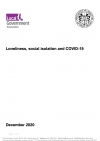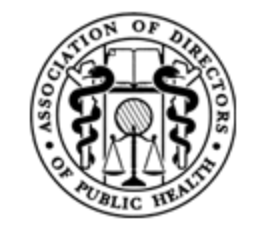
Introduction
The Local Government Association (LGA) and Association of Directors of Public Health (ADPH) have jointly produced this practical advice for Directors of Public Health and others leading the local response to the loneliness and social isolation issues arising from the COVID-19 outbreak. It follows on from our guidance about the public mental health impacts across the life course.
Public health teams in councils are working closely with partners, especially the voluntary and community sector (VCS) to tackle loneliness and social isolation. Intervening early to tackle loneliness and social isolation during the COVID-19 outbreak and beyond will help to prevent more costly health and care needs from developing, as well as aiding community resilience and recovery. This can only be done at the local level through partnerships between the council, voluntary and community sector, councillors, Primary Care Networks and relevant others.
Councils have a key role to play in this, because they own most of the assets where community action could or should take place, such as parks, libraries and schools, with councillors creating the localised neighbourhood partnerships to deal with a range of mental and physical health issues. Councils are also responsible for public health, adult social care and children and young people’s services. All of these services have a significant impact on tackling loneliness at a local level. The pandemic has also highlighted the importance of community volunteering in addressing loneliness.
Recent research[i] on loneliness during the pandemic has three main findings:
- People who felt most lonely prior to Covid in the UK now have even higher levels of loneliness. This increase began as physical distancing, shielding and lockdown measures were introduced in the UK, in March 2020.
- Adults most at risk of being lonely, and increasingly so over this period, have one or more of the following characteristics: they are young, living alone, on low incomes, out of work and, or with a mental health condition.
- The impact on wellbeing from people at risk of loneliness is likely to be compounded by other economic and social impacts experienced by the same people, such as those experiencing job losses and health anxieties.
Research also found that risk factors for loneliness were near identical before and during the pandemic. Young adults, women, people with lower education or income, the economically inactive, people living alone, and urban residents had a higher risk of being lonely. Some people who were already at risk for being lonely (e.g. young adults aged 18-30, people with low household income, and adults living alone) experienced a heightened risk during the COVID-19 pandemic compared to before COVID-19. Further, being a student emerged as a higher risk factor during lockdown than usual[ii]
[i]How has Covid and associated lockdown measures affected loneliness in the UK? What Works Wellbeing in partnership with UCL. 2020.
[ii] Who is lonely in lockdown? Cross-cohort analyses of predictors of loneliness before and during the COVID-19 pandemic. Feifei Bu, Andrew Steptoe, Daisy Fancourt
Leading local responses
Many councils are already using local insight and networks, including from ward councillors to identify people who may be isolated or experiencing loneliness during COVID-19 and to make them aware of potential support, building upon lessons learnt from the first wave.
The LGA’s ‘Must Know Guide’, drawing on work by the ‘Campaign to End Loneliness and Age UK’, sets out councils’ role working with partners and using community assets to address and help prevent loneliness and social isolation. The table below shows how these core responses are being adapted to reflect the COVID-19 situation, including the positive changes that are happening.
| Role of council working with local partners | Key steps to prevent and address loneliness and social isolation | Adjustments to local actions that may be required as a result of COVID-19 and opportunities to embed positive changes |
|---|---|---|
| 1. Foundation services that provide the first steps in finding individuals who are experiencing loneliness | Includes – first contact schemes, targeting people at risk of loneliness, formal social care assessments, social prescribing in primary care, home from hospital or admissions avoidance schemes, information about activity to tackle loneliness available through community settings |
|
| 2. Direct interventions focussed on helping people maintain existing relationships and develop new ones | Includes – supporting group activities such as lunch clubs and walking groups, one-to-one approaches like befriending schemes, access to psychological support for people for whom loneliness is part of broader mental health issues |
|
| 3. Structural enablers are people or organisations that encourage communities or individuals to engage with, and support, each other |
Includes – VCS commissioned projects such as community navigators/connectors. Specific community approaches that support tackling loneliness include:
|
|
| 4. Gateway services are broad services like transport, technology, spatial planning and housing, which make it easier for communities to come together | Examples include:
|
|
Further information
- Resources on the LGA website including practice examples
- Guidance on ADPH website
- Summary of Government work on tackling loneliness with useful links
- Let’s talk loneliness campaign
- Connection Coalition – includes Jo Cox Foundation, British Red Cross, Facebook, Age UK and others.
- Campaign to End Loneliness – new guide: ‘Promising Approaches Revisited: Effective action on loneliness in later life’
- Every Mind Matters
- LGA, ADPH and PHE COVID-19 Place based approach to reducing health inequalities from COVID-19
- Carers UK
- Mind
- Silverline
- Alzheimer’s Society
- Housing LIN
- Centre for Ageing Better guide to engaging older volunteers in the wake of COVID-19
- WHO Mental Health Considerations
- Real World Public Mental Health podcast, hosted by the Behavioral Science and Public Health Network (BSPHN), looks at how evidence is being used in the real world to prevent and promote better mental health for all. It is part of a public mental health collaboration between BSPHN, PHE, ADPH, LGA, Centre for Mental Health, Mental Health Foundation and NIHR – School for Public Health Research. The podcast series follows the webinar Prevention and Promotion for Better Mental Health in Local Systems, hosted by PHE in November 2020 on behalf of the collaboration, which can be viewed on the COVID-19 public mental health community of practice

